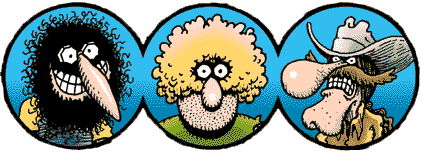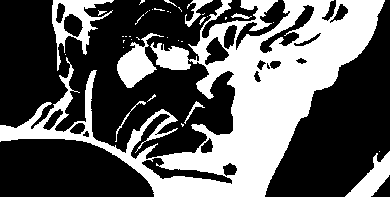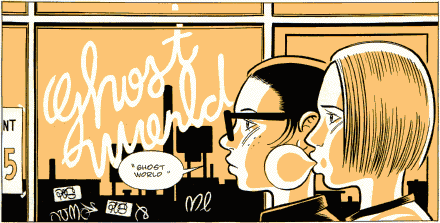
Alternative comics usually show about anything you cannot find in mainstream comics, and if you think this means few subjects, you are wrong. Also, alternative comics show the same stuff presented in mainstream comics, but in a different, particular way of view. In mainstream comics you may found the main super heroes of our times, comics version of literature classics, maybe some science fiction & fantasy, and some more genre based comics (romance, kids stories, etc.). In alternative comics there's a good chance of not meeting super heroes, fantasy, or scapism in a general way. You may find the adventures of a unemployed writer looking for job, odds in the life of a small city citizens or... a relate to a misconduct holiday trip.

As hard to define what alternative comics are when they begun to be done. Always come to mind the comics Robert Crumb did in late 60's, but before him there already were Harvey Kurtzman parodies in Mad magazine, that satirized the most famous characters of his time, super heroes comics and the american way of life. But with Crumb begins the tradition of hand made comics, with a strong authorial touch, creator owned characters. We can list in this line Gilbert Shelton's Freak Bros., Victor Moscoso and S. Clay Wilson, who influenced creators since then. The main difference their work had when compared with the mainstream one was the presence of themes so far absent, like drug abuse, sex, violence in a higher degree, social comment. Also, their way of drawing had more freedom, rough like, unpolished one, apart from the main tone found in mainstream comics.

The impact of the gang, Crumb ahead,
was nothing less than a revolution on the way of telling stories, picturing
characters, creating breakdowns in the comic book medium that influenced
even mainstream comics -- actually, on the seventies, super heroes comics
introduced themes considered taboo. In a 1969's Spiderman
tale, Harry Osborn, a friend of Peter Parker (secret identity of web-slinger)
was caught using LSD. In 1972 Green Arrow discover that his
pupil, Speedy, was using injectable drugs. Both issues came without
the Comics Code Authority stamp, which was beginning to loose influence
over the publishers.
 The
direct sales market was another huge change, because it opened space to
alternative comics as age oriented comics. The focus on creator owned magazines
increased, and many titles were born, though the market for comics was
not so good in late 70's. But we can list, since 1980: American Flagg,
by Howard Chaykin, Jon Sable Freelance, by Mike Grell,
Flaming Carrot Comics, By Bob Burden, Love
and Rockets, by Jaime & Gilbert Hernandez, Maus,
by Art Spiegelman, Cerebus,
by Dave Sim, Concrete, by Paul Chadwick, Teenage
Mutant Ninja Turtles, by Kevin Eastman and Peter Laird.
Many of them worked also doing mainstream comics, and choose to do their
own stories due to the possibility of show more personnel points of view,
and have more freedom to do this.
The
direct sales market was another huge change, because it opened space to
alternative comics as age oriented comics. The focus on creator owned magazines
increased, and many titles were born, though the market for comics was
not so good in late 70's. But we can list, since 1980: American Flagg,
by Howard Chaykin, Jon Sable Freelance, by Mike Grell,
Flaming Carrot Comics, By Bob Burden, Love
and Rockets, by Jaime & Gilbert Hernandez, Maus,
by Art Spiegelman, Cerebus,
by Dave Sim, Concrete, by Paul Chadwick, Teenage
Mutant Ninja Turtles, by Kevin Eastman and Peter Laird.
Many of them worked also doing mainstream comics, and choose to do their
own stories due to the possibility of show more personnel points of view,
and have more freedom to do this.

 The
scope is widened. Super hero parody, trash, futurism, ecological concern,
social comment, action, History, fantastic realism, anything can be shown
in a comic page. The space for unusual issues were already opened, and
the new authors used their creativity to capture the readers' attention.
Even on the super hero genre, changes conquer space with new views on old
characters and concepts, such as Batman (The Dark Knight
& Year One by Frank Miller; Killing Joke, by Alan
Moore), Daredevil (Frank Miller,
again), Watchmen and Swamp Thing (by Alan
Moore), The Shadow (by Howard Chaykin) or Animal
Man (by Grant Morrison).
The
scope is widened. Super hero parody, trash, futurism, ecological concern,
social comment, action, History, fantastic realism, anything can be shown
in a comic page. The space for unusual issues were already opened, and
the new authors used their creativity to capture the readers' attention.
Even on the super hero genre, changes conquer space with new views on old
characters and concepts, such as Batman (The Dark Knight
& Year One by Frank Miller; Killing Joke, by Alan
Moore), Daredevil (Frank Miller,
again), Watchmen and Swamp Thing (by Alan
Moore), The Shadow (by Howard Chaykin) or Animal
Man (by Grant Morrison).
In the nineties the alternative comics face the challenge of comic books'
lack of audience, being pointed as solution in the quest for new readers.
Alternative comics would have the necessary characteristics to grab potential
readers, because of their unique way of telling stories that has no similarity
in movies, literature or theater. Authors choose to do their own comics,
self- publishing their magazines, trying to be financially successful:
Mark Oakley (Thieves & Kings), David Mazzuchelli
(Rubber Blanket), Jeff Smith
(Bone), Mike Allred (Madman), Daniel
Clowes (Eightball), Eddie
Campbell (Bacchus), Rick Veitch (Rare Bit Fiends),
David Lapham (Stray Bullets), Frank
Miller (Sin City), Peter Bagge (Hate). That's
what we call now "indies" (as we named "underground" Crumb's comics
before). Again, the medium got a new strength to follow in its long and
far way.
